February 11, 2020

Regardless of where you farm in Minnesota, wet weather probably limited your ability to get into the field to do fall tillage if it didn’t prohibit it completely.
If you didn’t till in the fall, spring tillage is probably on your radar. Here are four tips to help make it as successful as possible:
1. Hit the right depth. The challenge with spring tillage is doing a tillage pass that’s deep enough to incorporate residue but not so deep that it brings up mudballs, clods or lumps, which is easy to do in wet spring soil. These then bake as the weather warms and can turn solid, making for a very rocky seedbed.
Usually, using less-invasive tillage methods such as vertical tillage or disking, as opposed to more intense means such as chisel plowing or deep ripping, are good options to achieve the right amount of depth with the least amount of disturbance.
If you were able to do fall tillage, you’ll be steps ahead in the spring.
2. Minimize compaction. Tillage is a double-edged sword: You till to reduce compaction, yet tillage disrupts soil structure, increasing the odds of compaction occurring. Tillage loosens the soil, which makes it easier to level off and incorporate residue to prepare a good seedbed. Anytime you disrupt soil structure through tillage, soil becomes light and fluffy at first, which is ideal.
However, since that structure has been disrupted, the weeks following tillage can see soil get packed down tighter. Wheel traffic makes soil more susceptible to compaction, so do your best to wait until soil is fit to work before you plant.
3. See compaction at the micro level. Although incorporating residue is an important part of conventional tillage, rainfall on conventionally tilled bare soil damages soil structure at the surface, which could lead to crusting issues. This can make it more difficult for young seedlings, especially soybean seedlings, to emerge.
One of the advantages of a no-till system is that it retains residue on the soil surface to help intercept rain droplets and minimize crusting. Although we think of heavy equipment as the chief culprit in compaction, the microscopic surface crusting caused by individual raindrops disrupting soil structure also plays a role.
4. Consider no-till soybeans. Even though many acres in Minnesota that host soybeans after corn are conventionally tilled, don’t think no-till soybeans can’t work for you. Even in Iowa, Illinois and the Dakotas, where heavy clay soils are prevalent, farmers are making no-till soybeans work with minimal, if any, yield penalty versus what they could achieve with conventional tillage.
This might be a good time to consider planting no-till soybeans into standing cornstalks, since soybeans can tolerate a no-till seeding environment better than corn can. They don’t need perfect seeding depth or perfect moisture at planting. They’ll soak up rain and still sprout.
If you couldn’t till last fall, think about incorporating no-till soybeans into your farm plan. If you do, you may need to consider a burndown application, so talk with your agronomist about how to best achieve that type of weed control.
Glady is a regional agronomist with WinField United in west-central Minnesota. Contact him at [email protected].
You May Also Like




